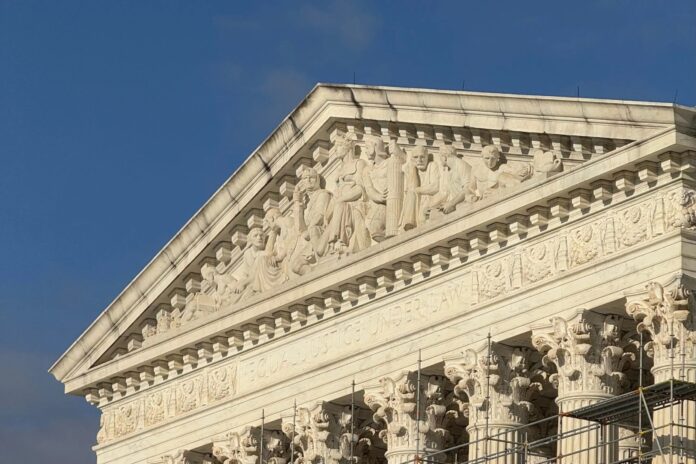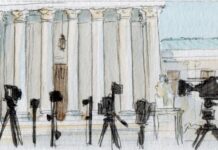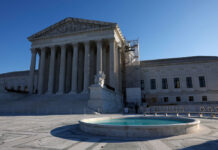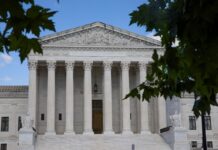Get ready to question how you spent your youth. On this day in 1811, Joseph Story, then just 32 years old, was confirmed to the Supreme Court. He remains the youngest justice to have ever served on the court.
SCOTUS Quick Hits
- In its Monday order list, the court announced that it will hear argument in Noem v. Al Otro Lado, a case on federal immigration law and the government’s authority to prevent asylum seekers from entering the United States. For more on the order list, see the On Site section below.
- Also on Monday, the Trump administration and lawyers for Illinois and Chicago filed what are expected to be their final briefs on President Donald Trump’s authority to deploy the National Guard to Illinois.
- Former Justice Stephen Breyer is scheduled to speak to students at Suffolk University in Boston on Thursday morning. The event is closed to the public.
Morning Reads
- Fed Governor Lisa Cook Offers First Defense of Mortgage Records (Nick Timiraos, The Wall Street Journal)(Paywall) — In a letter to U.S. Attorney General Pam Bondi, “Federal Reserve governor Lisa Cook’s lawyer on Monday provided the first detailed defense of her mortgage applications, arguing that apparent discrepancies in loan documents were either accurate at the time or an ‘inadvertent notation’ that couldn’t constitute fraud given other disclosures to her lenders,” according to The Wall Street Journal. “President Trump has sought to fire cook from the Fed over alleged fraud involving her mortgage applications,” but the “Supreme Court has for now blocked Trump’s attempt to remove her and will hear arguments in January.”
- Texas National Guard troops expected to leave Chicago and return home, source says (Dalia Faheid, CNN) — As the Supreme Court weighs Trump’s authority to deploy the National Guard to Chicago, some of the troops that have been there awaiting the justices’ decision are heading home, according to CNN. “Two hundred federalized [Texas National Guard] troops had arrived in the city over a month ago with a mission from the Trump administration to protect Immigration and Customs Enforcement and other US Government personnel – but instead stayed waiting at training bases for weeks” because of the legal battle over the deployment. The changes to the deployment are not expected to affect the 300 troops federalized from the Illinois National Guard.
- Supreme Court not ready to tackle prayers at football games again (Maureen Groppe, USA Today) — In its Monday order list, the court announced that it had “rejected an appeal from a Christian high school that was blocked from leading a communal prayer before a state championship football game,” according to USA Today. “The court’s decision not to get involved doesn’t have a practical effect on Cambridge Christian School, which sued the Florida High School Athletic Association in 2015 after its request to pray over the loudspeaker was denied. Since then, Florida passed legislation requiring the athletic association to allow schools to make opening remarks at games it oversees, and the FHSAA has said that includes communal prayers.” However, it does mean that the court at this time will not further clarify what types of public prayers violate the establishment clause; the school had contended that such clarification was needed to ensure that public programs did not needlessly prevent expressions of faith.
- US Supreme Court won’t hear patent appeal against Apple, Google, LG (Blake Brittain, Reuters) — Monday’s order list also showed that the court won’t weigh in on a dispute “involving the right to challenge expired patents, leaving in place a win for Apple, Google, and LG Electronics,” according to Reuters. Gesture Technology Partners, which had challenged “a decision to invalidate a patent that it had accused the technology companies of infringing,” had contended that the U.S. Patent and Trademark Office’s Patent Trial and Appeal Board does not have the authority to review expired patents and that the case should have been “reviewed by federal courts” instead.
- Gupta Wessler Nabs High Court Veteran From Justice Department (Alex Ebert, Bloomberg Law)(Paywall) — A seasoned Justice Department lawyer “with thirteen US Supreme Court arguments on his resume” is moving to “plaintiff-side Washington appellate boutique Gupta Wessler,” according to Bloomberg Law. “Matt Guarnieri is joining as a principal, adding another oral advocate to a practice that is already a routine high court player. In a social media post announcing the hire, the firm said its lawyers have now argued 33 cases before the high court—the most in recent years among plaintiff-side groups.”
A Closer Look: A Brief History of Supreme Court Clerkships
In his latest Empirical SCOTUS column for SCOTUSblog, Adam Feldman explored the idea that a Supreme Court justice’s most lasting legacy is the clerks he or she mentors, because former clerks often go on to exert a significant influence on the federal judiciary, such as by serving as judges (or justices) themselves.
But what you may not have realized when reading that column is that this avenue of influence wasn’t available to the justices until the late 19th century, nearly a century after the court began its work. Until then, there was no budget for justices to have a law clerk. Instead, they each had only a messenger, someone who could run opinion drafts or other dispatches back and forth from their home to the homes of the other justices. (There was no Supreme Court building until 1935 – the court would meet in different locations, although principally within the U.S. Capitol building.)
The Supreme Court’s clerk situation began to change in the 1880s, when Justice Horace Gray joined the court. As Justice Amy Coney Barrett outlined in her book, Listening to the Law, Gray had gotten used to working with a clerk while serving as a Massachusetts state court judge, and he paid out of pocket to continue having one after he was appointed to the Supreme Court in 1882.
Four years later, in 1886, Congress appropriated the funds necessary for not just Gray but for every justice to hire a clerk or stenography assistant. The court’s docket was rapidly expanding, and U.S. Attorney General Augustus Garland had advised lawmakers to offer funds for additional court employees, “emphasizing that cabinet officials and senators had comparable assistants,” Barrett wrote.
In the late 19th and early 20th centuries, the work of these clerks or assistants varied widely depending on which justice they served. Some were more like professional typists, while others did in-depth legal research. All, however, took on some unusual tasks, including running personal errands.
In the 1920s, Congress authorized each justice to hire a second law clerk, and in the 1940s, Congress gave each justice a third. It was around this time that all the justices began relying on their clerks to do more substantive work, such as reviewing cert petitions, a task that is still core to clerks’ work today.
Congress allocated even more money to the court in the 1970s, making it possible for each justice to hire up to four clerks. Four is still the magic number on the court today, although the chief justice is allowed up to five.
In Listening to the Law, Barrett wrote that it would be “impossible” to describe the work of the Supreme Court without describing the contributions made by clerks. In addition to screening potential cases, they help their justice prepare for oral argument, draft opinions, and review opinion drafts from other chambers.
And after their Supreme Court clerkship is done, former clerks often go on to have impressive legal careers, as Feldman wrote. Six of the current justices previously served as Supreme Court clerks (all but Justices Clarence Thomas, Samuel Alito, and Sonia Sotomayor.)
SCOTUS Quote
“Absolute discretion is a ruthless master. It is more destructive of freedom than any of man’s other inventions.”
— Justice William O. Douglas in United States v. Wunderlich
On Site
From Amy Howe
Court to Hear Case on Border Crossings
The Supreme Court on Monday agreed to review a ruling by a federal appeals court that, the Trump administration contends, “has already caused—and, if left in place, will continue to cause—‘untold interference with the Executive Branch’s ability to manage the southern border.’” The immigrant rights group and asylum seekers who filed the lawsuit had urged the justices to leave the decision by the U.S. Court of Appeals for the 9th Circuit in place, telling them that the government’s argument “would empower border officials to render” federal law governing the processing of asylum seekers “wholly inoperable at ports of entry.” For more on Noem v. Al Otro Lado, read Amy’s analysis.
Court Won’t Hear Appeals Regarding Prison Construction and School Prayer
Also on Monday, the court, over the objections of three justices, turned down an appeal from the sheriff of New Orleans in a dispute over the city’s obligation to build a new facility for inmates with mental health issues. Sheriff Susan Hutson had sought to end the city’s obligation by turning the court’s attention to a provision of the Prison Litigation Reform Act, a federal law that was intended to reduce frivolous lawsuits by inmates, which provides for the cut-off of future-oriented relief after two years. For more on this case and other notable developments from Monday’s order list, read Amy’s analysis.
Contributor Corner
The Case that Turned the Justices into Art Critics
In her latest In Dissent column, Anastasia Boden revisited Andy Warhol Foundation for the Visual Arts v. Goldsmith, a case on the “fair use” defense to copyright infringement. Boden reflected on how Justice Elena Kagan “used paintings, music, and literature” in her dissent “to school the majority on art history — and the very nature of judging.”
Posted in Featured, Newsletters
Recommended Citation:
Kelsey Dallas,
SCOTUStoday for Tuesday, November 18,
SCOTUSblog (Nov. 18, 2025, 9:00 AM),
https://www.scotusblog.com/2025/11/scotustoday-for-tuesday-november-18/





